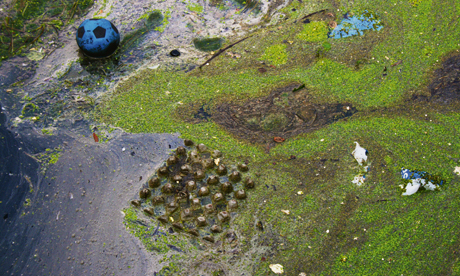River Lea not fit for fish warns report

Pollution in the River Lea is causing problems for fish. Photograph: Hackney Citizen
Pollution in the River Lea is running at unacceptably high levels with no signs of improvement in the immediate future, according to a new report.
University College London’s (UCL) water quality surveys have demonstrated that there are dangerously low levels of oxygen in the river’s water. The university has been working with Thames 21 since November 2010 monitoring the water quality in the Lea. Thames 21, which is London’s leading waterways charity, patrols this stretch of the river.
One method used to monitor pollution is to measure the levels of dissolved oxygen in milligrammes, per litre of water. The results recorded for the beginning of November are the worst yet and described by Thames 21 as: “truly shocking”.
In fact the water quality is so poor that in most places it is not even fit for the fish to live in it. Lea Angling Consortium used to run regular fishing competitions but now advise that there is little point fishing south of Tottenham lock at Ferry Lane.
This stretch of water runs from Bow Creek in the south, which is where the River Lea meets the Thames, all the way up to Enfield in the north.
UCL have scientifically recorded figures, and to put them in context, some explanation is required. The figures tell of milligrammes of oxygen per litre of water:
3mg/l is so poor that fish cannot live in this water.
6mg/l is generally regarded as a minimum acceptable level for wildlife.
9mg/l is regarded as a good, healthy level.
At four points in Hackney where oxygen levels have been measured, they are far lower than healthy levels. At Lea Bank the figure is 1.79mg/l, at Mabley Green it is 1.27mg/l, at North Millfields the level is 1.26mg/l, and at Watermint Quay the figure is 1.46mg/l.
One of the people who work for Thames 21 is Theo Thomas, who has worked on the water as a canal keeper for ten years. He is part of a team of six and spoke of the impact the pollution is having on the waterway’s environment.
Thomas described the River Lea as: “not healthy in any way and is heavily polluted.” He spoke of two things that were causing problems. Firstly untreated sewage that is allowed to flow into the river. This occurs at times of heavy rain and occurs as a result of excessive rainfall overloading the sewage system. This has been happening approximately once a month.
The Deephams Sewage Treatment Works which is near Pickett’s Lock in Edmonton serves a population of 850 000 people in north London. This plant discharges into Pymmes Brook, this is where water is at it’s warmest as it joins the river Lea causing sewage bacteria to multiply using oxygen in the water. This results in dissolved oxygen levels falling. Thomas says: “this situation has been tolerated for too long.”
The second problem occurs because modern housing development has overloaded what are outdated systems. Deephams sewage treatment works will be upgraded to improve this situation, this will be a multi-million pound upgrade but the work will not be completed until 2017.
Thomas and his team have made a recent discovery; the development of sewage fungus that is only aided by pollution, they have long been aware that the river has dead zones.
He tells us that: “For the River Lea to recover and return as a healthy environment for wildlife would take years.” He believes environmental initiatives need to take place from now.
Part of the problem is that there are many people who appear to be responsible for the River Lea but nobody is taking the lead. The river flows through four London boroughs: Tower Hamlets, Hackney, Haringey and Enfield. Thames Water is responsible for householders’ water supply and disposal; the Environment Agency and British Waterways are also involved.
Thomas tells the Citizen that the waterways “are public spaces to be enjoyed, not treated as sewage ditches.”
The Citizen also contacted Thames Water about the problem. A Spokesperson for the company said:
“We are working with Thames 21 to improve the quality of the river and as well as the upgrade of the sewage works we are also increasing the size of the storm tanks which will have a big impact on reducing discharges and will be completed next year.
“A major problem we face in the Lee Valley is the number of misconnections from domestic properties in this area that also pump raw sewage into the river and we are working with the Environment Agency on this to encourage people to ensure their drains are connected to the sewer drains and not the surface water drains.”
